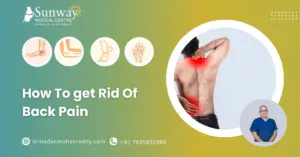A curved spine can impact posture, balance, and overall well-being, often leading to pain or discomfort in daily activities. This condition, seen in forms like scoliosis, kyphosis, or lordosis, causes the spine to bend abnormally rather than remain straight. Understanding how to fix a curved spine involves recognizing its causes and exploring suitable treatment options. While severe cases may require surgery, many can be managed with targeted exercises, posture correction, and lifestyle changes. With the right care, it’s possible to restore spinal alignment and improve mobility naturally.
What is a Curved Spine?
The spine naturally has soft curves that help our bodies balance and move comfortably. But sometimes, those curves become more pronounced than they should be, creating what’s called a spinal curvature. In children, this can affect their posture, movement, and even confidence.

A curved spine doesn’t always mean something serious is wrong but it’s a signal worth paying attention to. Whether it’s mild or more noticeable, understanding the issue is the first step toward improvement.
Causes of a Curved Spine
Understanding the underlying causes of spinal curvature is essential for effective treatment and prevention.Here are a few key factors behind it:
- Genetics: Genetics: Some people are born with spinal irregularities that can gradually progress into curvature as they grow. Early awareness helps guide how to fix curve in lower back through posture correction, exercises, and proper medical support.
- Poor Posture: Prolonged sitting or standing in the wrong position can cause spinal misalignment, often leading people to seek solutions on how to fix a curved spine.
- Weak Muscles: Insufficient strength in the core and back muscles reduces spinal support, contributing to improper alignment.
- Injury or Trauma: Accidents or physical injuries can disrupt the natural curve of the spine, resulting in long-term posture issues if left untreated.
Symptoms of Spine Curvature Disorders
- Uneven Shoulders or Hips: A visible imbalance in body alignment may occur when curvature of the spine affects posture.
- Persistent Back Pain: Long-lasting discomfort, especially after prolonged sitting or standing, is a common sign of abnormal spine curvature.
- Restricted Mobility: Limited flexibility and difficulty performing routine movements often result from structural changes in the spine.
- Numbness or Tingling: In advanced cases, nerve compression caused by curvature of the spine may lead to numbness or tingling in the arms or legs.
Types of Curved Spine
There are a few types of spinal curvatures, and each has its own characteristics:
- Scoliosis: A sideways curve of the spine, often shaped like an “S” or “C”. It can appear in early childhood or during growth spurts.
- Kyphosis: This causes an exaggerated rounding of the upper back. Some kids may seem like they’re hunching, even when standing straight.
- Lordosis: A pronounced inward arch in the lower portion of the spine.
It can make the belly stick out more and the buttocks appear more prominent.
Learning how to straighten a curved spine or correct a curve in the lower back or upper spine depends on which type is present and how it affects your child’s movement and comfort. Back or upper spine depends on which type is present and how it affects your child’s movement and comfort.
What are the Signs of Scoliosis?
Recognizing the early signs of scoliosis is essential for timely treatment and better spinal health. This condition often develops gradually, so being aware of subtle changes can make a big difference in understanding how to fix a curved spine effectively.
- Uneven shoulders
- Shoulder blades that stick out
- Head not centered above the pelvis
- Uneven waist or hip height
- Constant leaning to one side
- Uneven leg length
- Changes in skin appearance or texture (dimples, hair patches, or discoloration) along the spine
If you notice any of these signs, consult a healthcare provider for a proper screening. Over time, additional symptoms may appear, such as slight height loss or uneven alignment of the pelvis and hips.
How to Straighten a Curved Spine
Now, the question most parents want answered: how to straighten a curved spine?
The good news is that many children respond well to conservative treatments that focus on alignment, strength, and posture. Here’s how to get started:
1. Physical Therapy: Trained therapists can guide children through exercises that strengthen their back, hips, and abdominal muscles helping stabilize the spine naturally. This is one of the most effective and non-invasive ways to begin.
2. At-Home Stretching and Movement: Simple routines at home like gentle back stretches, yoga for kids, and core exercises can support spine health. Make it playful and consistent.
3. Bracing (if recommended): For children with more noticeable curves (especially in scoliosis), a doctor may recommend a back brace to gently guide the spine’s growth. This isn’t painful and can be very effective in preventing further curvature.
4. Mindful Posture: Help your child develop good habits early: sitting upright, avoiding heavy backpacks, and using supportive chairs. These small changes can make a big difference over time.
5. Medical Treatment: In rare cases where the curve is severe or progressing quickly, surgical intervention may be needed. Pediatric spine specialists will walk parents through every step to ensure the best possible outcome.
What Part of the Spine Does Scoliosis Affect?
Scoliosis can affect different regions of the spine, depending on the type and severity of the curve. Understanding which part is involved is crucial in determining the right approach for treatment and learning how to fix a curved spine effectively.
- Thoracic Spine (Mid-Back): The most common area affected, causing uneven shoulders or rib prominence.
- Lumbar Spine (Lower Back): Curves here often lead to uneven hips or lower back pain.
- Thoracolumbar Spine (Mid to Lower Back): A combination curve that impacts both the thoracic and lumbar areas, often affecting posture balance.
- Cervical Spine (Neck Area): Rare but can influence head alignment and neck movement.
How to Fix Curve in Lower Back (Lumbar Lordosis)
Lumbar lordosis is a condition where the lower back curves inward more than normal.. Here’s how to address and improve it:
- Core Strengthening: Building strong core muscles supports the spine and helps maintain proper posture.
- Pelvic Tilts: This simple movement strengthens abdominal muscles and helps reduce lower back curvature.
- Stretching Hamstrings: Tight hamstrings can tilt the pelvis forward, worsening the curve, so regular stretching is beneficial.
- Physical Therapy: A customized exercise plan from a therapist can improve alignment and posture, guiding you on how to fix a curved back effectively.
Exercises to Correct a Curved Spine
Exercise is one of the best ways to correct spinal curvature. Some effective exercises include:
- Planks: Strengthen core muscles to enhance stability and support for a curved back.
- Bridges: Improve lower back alignment and help promote better overall posture.
- Cat-Cow Stretch: Increase spinal flexibility and gently reduce stiffness through controlled movement.
- Wall Angels: Encourage proper posture and help train the spine to maintain correct positioning.
How to Fix a Curved Spine with Physical Therapy
Physical therapy plays a crucial role in treating spinal curvature. A therapist will guide you through:
- Postural Training: Guiding you to develop and maintain proper posture throughout everyday movements.
- Muscle Strengthening: Focusing on strengthening the core and back muscles.
- Manual Therapy: Hands-on techniques to improve mobility and alignment.
- Stretching Routines: Improving flexibility to reduce strain on the spine and support your journey on how to straighten a curved spine effectively.
What are the Risk Factors for Scoliosis?
Several factors can increase the likelihood of developing scoliosis, making early awareness important for prevention and understanding how to fix a curved spine effectively. These risk elements vary from genetics to lifestyle influences and can affect people of all ages.
- Posture and Lifestyle: Poor posture, lack of exercise, and carrying heavy loads unevenly can gradually affect spinal alignment.
- Genetic Factors: A family history of scoliosis raises the risk of developing spinal curvature.
- Age and Growth Spurts: Rapid bone growth during adolescence can cause spinal misalignment, leading many to seek advice on how to fix a curved back.
- Gender: Scoliosis tends to progress more often in females than in males.
- Muscle or Nerve Conditions: Disorders like muscular dystrophy or cerebral palsy can increase spinal curvature risk.
Lifestyle Changes for a Healthy Spine
Maintaining a healthy spine involves daily habits:
- Regular Exercise: Build core strength to provide better support for the spine.
- Proper Ergonomics: Use supportive furniture and maintain good posture.
- Healthy Diet: Nutrient-rich foods help maintain bone health.
- Avoid Heavy Lifting: Improper lifting techniques can strain the back.
Conclusion
If you are looking for how to fix a curved spine, taking early action is essential. Whether through exercise, physical therapy, or professional treatment, improving spinal health is achievable. Dr. Madan Mohan Reddy advises a combination of lifestyle adjustments, targeted exercises, and medical intervention for the best results. Always consult a specialist to determine the best treatment for your specific condition.




